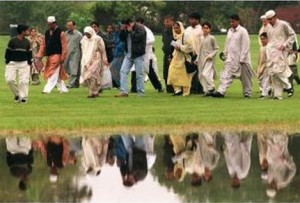Muslims celebrate Eid al-Adha in California
Published: Nov. 14, 2011 Updated: 1:00 p.m.
By SYED ANIS AHMAD / For THE ORANGE COUNTY REGISTER
As in other parts of the world, Muslims of California celebrated Eid al-Adha last week with great fervor and zeal, offering prayers in mosques and other places.
The Eid al-Adha, or festival of sacrifice, is the second biggest religious festival observed by Muslims, after Eid al-Fitr, which precedes the fasts of Ramadan. The holiday is known in the West as the occasion for Hajj pilgrimages to Mecca.
On the occasion, every Muslim capable of buying a lamb, goat, sheep, cow or camel is supposed to slaughter at least one animal to mark the Prophet Ibrahim’s (Abraham) willingness and act to sacrifice his eldest son Ismaeel (Ishmael) in obedience to a command from Allah (God) approximately four thousand years ago.
The three-day festivity started with the dawn on Nov. 6 and lasted till dusk on the 8th; on the Islamic calendar, it starts on the tenth day of the 12th month.
On the day, Muslims visit each other’s homes and typically eat the best of their local culture’s traditional cuisine, especially meat dishes. The elders give money (traditional ‘Eid’) to children.
Khalid Khan, a Tustin businessman of Pakistani origin, offered Eid prayers at the Hyatt Regency in Irvine.
He said it’s a big day for his family and everyone is happy on the occasion.
“It is very nice and overwhelming,” he said.
His son Ovais Khan, who is an IT student, said it was nice to meet so many Muslims together in one place.
“I enjoy hugging and embracing people with others during Eid days,” he said. “It’s a fun day of celebration and activities.”
Since the holiday is three days long, there’s time for people to visit public parks and arrange picnics.
Eid is a time for homecomings. It’s very common in Islamic regions for people to take some extra time off work to go home for the holiday.
Men, women, and children all dress up in their new and their finest clothing early in the morning on the day.
After offering Eid prayers on first day, the male members of the family get busy in sacrificing animals and preparing and distributing their meat. The whole day is passed in these activities.
The meat from the sacrificed animal is divided into three parts. The family retains one third of the share; another third is given to relatives, friends and neighbors; and the other third is given to the poor, the needy, and beggars. That’s part of a concerted effort to see that no impoverished person is left without an opportunity to partake in the sacrificial meal during these days.
People also visit graveyards to pay homage to their relatives by praying on their graves and seeking forgiveness from God.
In essence, all Muslim festivals and rituals are repetitions of the seeking God’s forgiveness and his blessings.
While Eid al-Adha is always on the same day of the Islamic calendar, the date on the Gregorian calendar varies from year to year since the Islamic calendar is lunar and the Gregorian calendar is solar, making it 11 days longer.
Contact the writer: Syed Anis Ahmad is a journalist at ‘The News’, Islamabad-Rawalpindi, Pakistan. He is reporting for Orange County Register in partnership with the International Center for Journalists. The program is funded by the U.S. Department of State


















